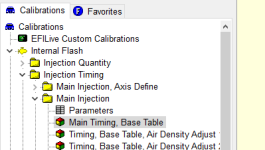Perhaps a bit of background is in order. I am fitting a Bosch H-1000 injection pump to my 12v motor. The H-Pump has dynamically variable timing (a total of 14.8° of pump advance, or 29.6° of crank advance; the pump spins at 1/2 crank speed).
What I am trying to do is figure out a general advance curve (RPM vs. Degrees of advance) and also a 3-D curve which would include throttle position and possibly MAP, or MAF. I downloaded the demo version of EFI Live and looked at a few curves that are in the library, but what I can't figure out is: Is there a static number degrees of initial timing, and the computer advances or retards from there. Or is the initial timing a very low number, perhaps even ATDC and then advances from that point. I am not concerned about emissions, so like I said I am just looking for a basic 2D curve and then modify it for additional advance under light throttle, light boost conditions. I'm convinced the ability to advance timing is the reason common rail motors can get higher power numbers & still remain streetable.
Also, something to consider, pilot injection is not possible with this pump, so total timing in degrees BTDC, not just advance from a certain point, is what I'm looking for.
I'm posting here because the P-Pump guys don't know much about dynamic timing because it doesn't apply to them; since the P-Pump can't dynamically advance.
Any positive input is appreciated. If further clarification of my project is needed, please don't hesitate to ask.
What I am trying to do is figure out a general advance curve (RPM vs. Degrees of advance) and also a 3-D curve which would include throttle position and possibly MAP, or MAF. I downloaded the demo version of EFI Live and looked at a few curves that are in the library, but what I can't figure out is: Is there a static number degrees of initial timing, and the computer advances or retards from there. Or is the initial timing a very low number, perhaps even ATDC and then advances from that point. I am not concerned about emissions, so like I said I am just looking for a basic 2D curve and then modify it for additional advance under light throttle, light boost conditions. I'm convinced the ability to advance timing is the reason common rail motors can get higher power numbers & still remain streetable.
Also, something to consider, pilot injection is not possible with this pump, so total timing in degrees BTDC, not just advance from a certain point, is what I'm looking for.
I'm posting here because the P-Pump guys don't know much about dynamic timing because it doesn't apply to them; since the P-Pump can't dynamically advance.
Any positive input is appreciated. If further clarification of my project is needed, please don't hesitate to ask.
Last edited:

